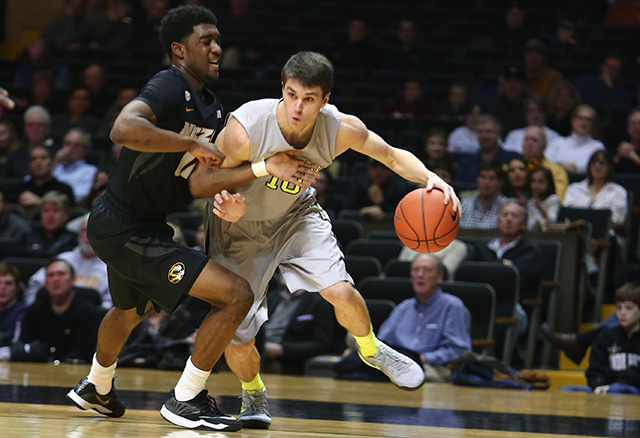Dec. 17, 2015

By Jerome Boettcher | Subscribe to Commodore Nation
More than 18 months ago, Nathan Watkins went to a Be The Match bone marrow and stem cell donation drive held by Vanderbilt’s Alpha Epsilon Pi chapter.
He was one of more than 2,000 students who underwent a simple cheek swab to be placed on the Be The Match Registry in hopes of becoming a potential donor. With several of his friends in Alpha Epsilon Pi, Watkins wanted to help their cause.
Of course, college students can’t resist free food, either.
“It didn’t hurt that they had free MacDougal’s (chicken) and Krispy Kreme donuts,” Watkins said with a smile. “That was a good incentive to show up.”
And it’s a good thing Watkins showed up. He was a match.
More than a year after the drive, this past June, heading into his senior season with the Vanderbilt men’s basketball team, Watkins heard from Be The Match. He was a potential stem cell transplant match for an older man who had been diagnosed with leukemia.
“With his specific type of leukemia, the stem cell or bone marrow is the best bet they are going to get,” he said. “The odds of getting called off the registry and asked to donate are extremely slim.”
Even with more than 11 million people on the registry, the odds of a match are rare. Just one in 540 Be The Match Registry members will donate bone marrow or peripheral blood stem cells (PBSC).
If a match is found, a registry member can still change his or her mind and decide not to donate – even on the day of the transplant. Donating is voluntary. Side effects from donating vary from person to person but can include back or hip pain, muscle pain, headaches, bruising at the incision site and fatigue. And the symptoms can last from a few days to several weeks.
When Watkins found out he was a match, though, he jumped on board right away.
“For me, I was obviously very for it from the start when I found out that I was a match,” said Watkins, who is a medicine, health and society major. “In the same type of sense, this could be my parents, any of my friends’ parents, this could be our coaches. It is all in the same age group. So it was definitely something I was very for.”
Once Watkins agreed, the recipient’s doctor had 60 days to consent. The donation was scheduled for August. Prior to that, Watkins, 22, underwent additional testing for infectious diseases, to ensure his blood levels were correct and to check that it would be safe for him and the recipient.
The week of the transplant, Watkins, a native of nearby Brentwood, Tenn., went to the Vanderbilt Clinic each day for five days. Each of the first four days, he received two injections of Filgrastim. The drug increased his stem cell count.
On the fifth day, he received two more shots of Filgrastim for a total of 10 for the week. The shots can cause side effects of flu-like symptoms, head aches and bone pain. Watkins said his pain was mild.
On the actual day of the transplant, the process took five hours. Blood from his right arm was drawn and funneled into an apheresis machine. The blood is spun and separated into plasma, platelets, white blood cells and red blood cells. The blood was sorted by density, allowing the doctors to collect the stem cells, along with platelets. The remaining blood was returned to his left arm.
The donated stem cell was then shipped to the recipient, who receives the transplant the day of or the next day. About 10 days before the transplant, the recipient receives radiation and chemo treatments to wipe out his immune system. So the window to receive the transplant is short.
In October, Watkins said he had received an update that everything is going as “well as we could have hoped.” His donor coordinator will give him updates one month after the transplant, then six months after and at the one-year mark. To respect his privacy, only the recipient’s age, gender and disease are disclosed. After one year, if both parties consent to it, Watkins will receive contact info for the recipient.
“I am definitely going to consent to opening up communication,” he said. “I think at some point I would like to at least talk to him and see how everything is going for him.”
In the meantime, Watkins plans on encouraging his friends, teammates and peers to get registered for Be The Match.
The National Marrow Donor Program has saved numerous lives. Vanderbilt cross country and track head coach Steve Keith is living proof.
Two years ago, Keith became suddenly ill at the SEC Indoor Track Championships from what he thought was a virus. It turned out he had myelodysplastic syndrome (MDS), a type of cancer that prevents the bone marrow from producing enough healthy blood cells. The disease formed into Adult Acute Myeloid Leukemia (AML) and nearly took his life, but he was fortunate the following fall, in September of 2013, to receive a bone marrow transplant that offered him his “second birthday.” His donor came internationally from a 25-year-old male in Germany.
Two years later, at age 55, Keith is as healthy and as active as ever. He was afforded a second lease on life thanks to a donor from Be The Match.
“It is a really simple process just to get on the registry,” Watkins said. “It is BeTheMatch.org. You can either go to a drive or they’ll send you the kit. It is just a cheek swab, and you mail it back and you’re on the registry. It has certainly helped a lot of people.”


